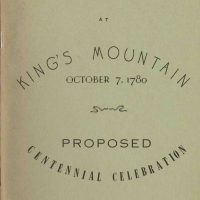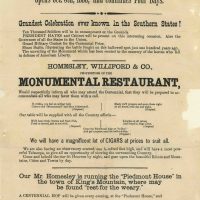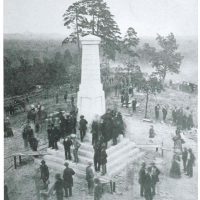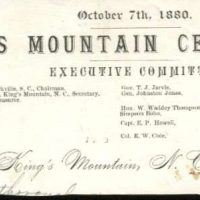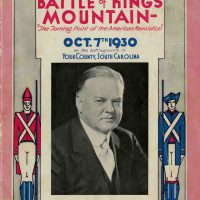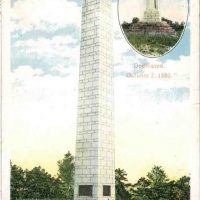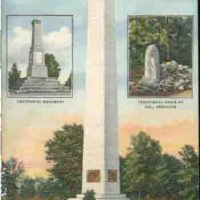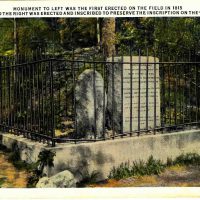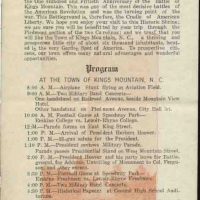On October 7, 1780, the heroic and strategic triumph of Southern Patriots over Loyalist forces occurred at the battle of Kings Mountain in York County, South Carolina. The Commemorating Kings Mountain project aims at two purposes: firstly, to pay tribute to the legendary Revolutionary War battle of Kings Mountain, and secondly, to illustrate how the members of the community celebrated the anniversary of this event throughout the years.
The Commemorating Kings Mountain project is supported by a grant from the Library Services and Technology Act (LSTA), as administered by the State Library of North Carolina, a division of the Department of Cultural Resources. The partners of this project are united in their mission to preserve and enhance the history, education, and culture of Kings Mountain, North Carolina and the surrounding region. These partners are Mauney Memorial Library, Kings Mountain Historical Museum, and Kings Mountain National Military Park.
1880 Centennial Celebration
President of the United States: Rutherford B. Hayes
Vice President of the United States: William Wheeler
By the year 1880, the South was continuing to rebuild after the destruction of the Civil War. In particular, the historical and cultural identity of Kings Mountain was rapidly transforming. The city of Kings Mountain was incorporated in 1874, changing its name from White Plains to Kings Mountain as an homage to the Revolutionary War battle that shaped the region. Six years later, members of the new community assembled together to conduct the first official celebration for the 100th anniversary on October 7, 1880. As a turning point in the Revolutionary War, the battle of Kings Mountain deserved recognition. Thus, the centennial celebration included the unveiling of the Kings Mountain Monument on the battleground. One of the inscriptions on the monument reads, “Here the tide of the battle turned in favor of the American Colonies.” The celebration aimed to show the gratitude and respect for what was lost and what had been gained that day one hundred years prior. In an original souvenir program, the event is described as the “Grandest celebration ever known in the Southern States!” The 1880 Centennial Celebration was the first of its kind and paved the way for larger, grander celebrations in the future.
Proposed Centennial Celebration
Publication date:
A booklet with planning details for the centennial celebration, including the following: Organization of the King’s Mountain Centennial Association Correspondence between the Governors of Tennessee, North Carolina, South Carolina, and Virginia Act of the General Assembly of South Carolina, making appropriation to aid in the celebration Resolution of the General Assembly of North Carolina, making … Continue reading Proposed Centennial Celebration
Letter from Virginia Governor Frederick Holliday
Publication date:
A letter from Governor Frederick Holliday of Virginia responding to an invitation to the Centennial celebration. Full Text Richmond, VA Sept. 16 1880 J.W. Garrett Esq. W. CC. Dear Sir: Your very kind invitation ?? to attend the Kings Mountain Celebration in October. I thank you cordially, and will do so with great pleasure, unless official duties prevent, which … Continue reading Letter from Virginia Governor Frederick Holliday
Letter from Vermont Governor Redfield Proctor
Publication date:
A letter from Governor Redfield Proctor of Vermont responding to an invitation to the Centennial celebration. Full Text Sutherland Falls, September 17th, 1880 J. W. Garrett, King’s Mountain, North Carolina. Dear Sir: It would give me great pleasure to attend your centennial, but it comes at the opening of the session of our legislature, which … Continue reading Letter from Vermont Governor Redfield Proctor
Celebration Activities Poster
Publication date:
This poster lists the activities planned for the 1880 Centennial celebration of the Battle of Kings Mountain. Highlights Ten thousand soldiers encamped on the grounds President Rutherford B. Hayes, his cabinet members, and the governors of all the states in the Union would attend A hundred-foot observatory with a telescope would offer views of the … Continue reading Celebration Activities Poster
Centennial Celebration of the Battle of Kings Mountain
Publication date:
A photograph of crowds at the centennial celebration.
Colonel Ferguson’s Death Location
Publication date:
Photo taken in 1880 at the site of Colonel Ferguson’s death.
Kings Mountain Battleground First Monument
Publication date:
A photo of the first monument at the site of the Battle of Kings Mountain.
Programme for Centennial Day
Publication date:
A program of festivities held on Centennial Day, October 7, 1880. Includes the following: National Salute at sunrise Review of all troops at 10:00 AM Procession to grand stand at 11:30 AM Prayer by Rev. William Martin Singing of the lyric written for the occasion by Clara Dargan McLean from Yorkville, SC, with music written … Continue reading Programme for Centennial Day
Letter from Irma W. Thomson
Publication date:
A letter from Irma W. Thomson, daughter of Bennett Willeford, a merchant in the Kings Mountain area at the time of the Centennial Celebration. Full Text Mr. Moomair??, You will find enclosed the letterhead I have found among my late father’s effects and which I thought might be of some interest to visitors out there … Continue reading Letter from Irma W. Thomson
1930 Sesquicentennial Celebration
President of the United States: Herbert Hoover
Vice President of the United States: Charles Curtis
By the year 1930, the National Parks Service had been in place for over a decade, and it expanded to include the battleground of Kings Mountain. For the Sesquicentennial Celebration in 1930, the battle of Kings Mountain had gained traction on a national scale. President Herbert Hoover attended the celebration, which was the very first time that a sitting president traveled to a Southern battlefield. To the crowd of over 30,000 people, President Hoover said that “This is a place of inspiring memories.” President Hoover spoke about the ideals that inspired the patriots at Kings Mountain and the forefathers of the United States. In an original souvenir program from the event, the battleground is called the “Cradle of American Liberty.” This title perfectly sums up the decisive impact of the battle of Kings Mountain as a turning point in the war.
Envelope with Stamp
Publication date:
An air mail envelope with a commemorative return address stamp, mailed to Frank Herget, 553 Suffolk St, Buffalo, NY.
Souvenir Program Booklet from the Sesqui-Centennial Celebration
Publication date:
A souvenir program including the program of events for the 150th anniversary sesqui-centennial celebration on October 7, 1930. Includes the following: Advertisements for a number of area businesses Schedule of events, including President Herbert Hoover’s address Dedication of Ferguson Marker, with Mr. Ronald Campbell representing the British Government Descendants of Heroes, including addresses by the Hon. James … Continue reading Souvenir Program Booklet from the Sesqui-Centennial Celebration
Battle Monuments Postcard
Publication date:
A postcard comparing the monument dedicated October 7, 1880 with the newer monument dedicated October 7, 1911.
Colonel Ferguson’s Grave in 1930
Publication date:
A postcard with a photo of Colonel Patrick Ferguson’s grave.
Monuments in 1930
Publication date:
A postcard showing drawings of Colonel Ferguson’s grave marker, the Centennial Celebration monument, and the newer 1911 monument.
Original Monuments in 1930
Publication date:
Two nearly-identical postcards showing a photo of the old monument, erected in 1815 by Dr. William McLean of Lincolton, NC. The newer monument was later erected and inscribed to preserve the inscription on the “old monument.”
Souvenir from 1930 Celebration
Publication date:
A folding souvenir: when closed, shows a white silhouette of the monument overlaid on a photo of the mountain when opened, shows a short poem and some more information about the home-coming held October 3–7, 1930
Souvenir Program from the Sesqui-Centennial Celebration
Publication date:
A souvenir program with some introductory remarks and a list of events: 8:00 AM: Airplane stunt flying at Aviation Field 9:00 AM: Two military band concerts One on Railroad Ave. beside Mountainview Hotel One on Piedmont Ave. at the City Hall lot 10:00 AM: Football game at Speedway Park: Erskine College vs. Lenoir-Rhyne College 12:00 … Continue reading Souvenir Program from the Sesqui-Centennial Celebration
1980 Bicentennial Celebration
President of the United States: Jimmy Carter
Vice President of the United States: Walter Mondale
In the first major celebrations of the battle of Kings Mountain, the members of the community had dedicated a commemorative monument; the battleground was included in the National Parks Service; and the incumbent president of the United States had addressed the crowd. For the Bicentennial Celebration in 1980, the most important milestones had already been reached. Thus, the celebration in 1980 focused on the battle itself and commemorating the historical event that occurred two hundred years prior. In a souvenir flyer, the description of the battle transports the modern reader into the past: “It was a crisp, quiet day in the late summer of 1780. But the stillness was broken by cannon and musket fire from the battle raging on Kings Mountain. Local frontiersmen against the crack British troops of Lord Cornwallis. The frontiersmen won, and many historians believe they turned the tide of the American Revolution.” The Bicentennial Celebration was built upon the achievements of the former celebrations in 1880 and 1930. Most importantly, the 1980 celebration showcased the military strategy that resulted in the legendary Patriot victory.
